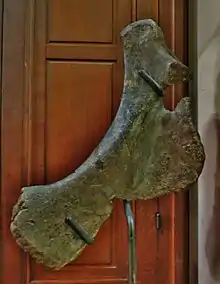Narindasaurus
Narindasaurus (meaning "lizard of Narinda Bay") is a genus of turiasaurian sauropod dinosaur from the Middle Jurassic Isalo III Formation of Madagascar.[1][2] The type species, N. thevenini was formally described by Royo-Torres et al. in 2020.[3] The holotype, which consists of one specimen, is currently stored at the Muséum national d’Histoire naturelle and has been since 1906 or 1907.[2]
| Narindasaurus Temporal range: Middle Jurassic, ~ | |
|---|---|
 | |
| Left pubis (MNHN MAJ 430) | |
| Scientific classification | |
| Domain: | Eukaryota |
| Kingdom: | Animalia |
| Phylum: | Chordata |
| Clade: | Dinosauria |
| Clade: | Saurischia |
| Clade: | †Sauropodomorpha |
| Clade: | †Sauropoda |
| Clade: | †Turiasauria |
| Genus: | †Narindasaurus Royo-Torres et al., 2020 |
| Species: | †N. thevenini |
| Binomial name | |
| †Narindasaurus thevenini Royo-Torres et al., 2020 | |
Discovery and naming
The holotype was discovered in the Isalo III Formation before 1894 by Joseph Thomas Last,[4] and were briefly noted on by Paul Lemoine in 1906.[1] Armand Thevenin (1861-1942) was the first to diagnose Narindasaurus. In 1907, he placed it within the now obsolete species "Bothriospondylus madagascariensis",[2] which is now known as Lapparentosaurus.[5] It was briefly mentioned in 1972[6] and it was reevaluated in 2008 and 2010 as both a distinct taxon and a non-neosauropod eusauropod.[7][8] It was classified as a turiasaur in 2015.[9] The species Narindasaurus thevenini was formally named in 2020.[3]
The holotype consists of a partial skeleton composed by a right maxillary or premaxillary tooth (MNHN MAJ 423), an anterior caudal vertebra (MNHN MAJ 424), a posterior caudal vertebra (MNHN MAJ 426), a middle-anterior chevron (MNHN MAJ 425), a right ulna (MNHN MAJ 427), a right tibia (MNHN MAJ 428), a right fibula with a distal chevron attached (MNHN MAJ 429) and a left pubis (MNHN MAJ 430).[2][3]
Gallery
 Right fibula (MNHN MAJ 429)
Right fibula (MNHN MAJ 429)
References
- Lemoine P. 1906. Études géologiques dans le nord de Madagascar. In: Herman A, ed. Contributions à l’histoire géologique de l’Océan Indien. Paris: Librairie Scientifique, 1–520.
- Thevenin A. 1907. Paléontologie de Madagascar. IV Dinosauriens. Annales de Paléontologie 2: 121–136.
- Rafael Royo-Torres; Alberto Cobos; Pedro Mocho; Luis Alcalá (2020). "Origin and evolution of turiasaur dinosaurs set by means of a new 'rosetta' specimen from Spain". Zoological Journal of the Linnean Society. 191: 201–227. doi:10.1093/zoolinnean/zlaa091.
- Lydekker, R. (1895). "On bones of a sauropodous dinosaur from Madagascar". Quarterly Journal of the Geological Society of London. 51 (1–4): 329–336. doi:10.1144/gsl.jgs.1895.051.01-04.25. S2CID 128431891.
- Bonaparte, J.F. (1986). "Les dinosaures (Carnosaures, Allosauridés, Sauropodes, Cétosauridés) du Jurassique Moyen de Cerro Cóndor (Chubut, Argentina)". Annales de Paléontologie (Vert.-Invert.). 72 (3): 325–386.
- Besairie H, Collignon M. 1972. Géologie de Madagascar, 1. Les terrains sédimentaires. Annales Géologiques de Madagascar 35: 1–463.
- Läng E. 2008. Les cétiosaures (Dinosauria, Sauropoda) et les sauropodes du Jurassique moyen: révision systématique, nouvelles découvertes et implications phylogénetiques. Unpublished Ph.D Thesis, Muséum national d’Histoire naturelle, Paris.
- Mannion PD. 2010. A revision of the sauropod dinosaur genus ‘Bothriospondylus’ with a redescription of the type material of the Middle Jurassic form ‘B. madagascariensis’. Palaeontology 53: 277–296.
- Mocho, Pedro; Royo-Torres, Rafael; Malafaia, Elisabete; Escaso, Fernando; Silva, Bruno; Ortega, Francisco (2015-06-19). "Turiasauria-like teeth from the Upper Jurassic of the Lusitanian Basin, Portugal". Historical Biology. 28 (7): 861–880. doi:10.1080/08912963.2015.1049948. ISSN 0891-2963. S2CID 129076933.










